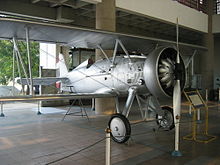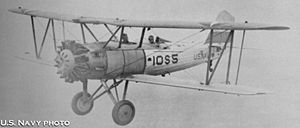- Vought O2U Corsair
-
O2U Corsair O2U-4 Corsair Role Observation National origin United States Manufacturer Vought Introduction 1926 Primary users United States Navy
United States Marine Corps
United States Coast GuardNumber built 580 The Vought O2U Corsair was a 1920s biplane scout and observation aircraft. Made by Vought Corporation, the O2U was ordered by the United States Navy (USN) in 1927. Powered by a 400 hp (298 kW) Pratt & Whitney R-1340 Wasp engine, it incorporated a steel-tube fuselage structure and a wood wing structure with fabric covering. Many were seaplanes or amphibians.
Contents
Design and development
In 1927, a total of 291 O2Us were produced. The O2U-2, -3 and -4 were ordered in 1928 with minor changes. By 1930 they were being superseded by the O3U which was basically similar to the O2U-4, one of which was fitted with the Grumman float, and were manufactured until 1936. A total of 289 were built.[1] Many of them had cowled engines and some had enclosed cockpits.
Operational history
The 600-690 hp (448-515 kW) Pratt & Whitney R-1690-42 Hornet engine was used to power Corsairs designated SU-1 to SU-4. The change in designation reflected their role as scouts. A total of 289 SU designated aircraft were built for the USN. No less than 141 Corsairs were still serving with the US Navy and Marines when the US entered World War II.
Export versions included the Corsair V-65F, V-66F and V-80Fp for the Argentine Navy, the V-80P for the Peruvian Air Force, and the V-85G for Germany.[1] Japan purchased Corsair variants V-65C and V-92C. Brazil purchased 36 aircraft V-65B, some hydroplanes V-66B and 15 V-65F.
In March 1929, Mexico purchased 12 armed aircraft O2U-2M versions with the 400 hp (300 kW) Wasp engine to quell a military coup; Mexico then built 31 more units under licence, and called them Corsarios Azcárate O2U-4A. In 1937, Mexico purchased 10 V-99M equipped with the Pratt & Whitney R-1340-T1H-1 550 hp Wasp engine, some of them may have been sent to Spain.[2]
China purchased the 42 export versions of O2U-1 from 1929-1933, and 21 export versions of O3U between 1933-1934 and they saw extensive bombing actions. The O2U-1 versions participated in the Central Plains War and in the January 28 Incident against the Japanese targets, while the O3U versions first participated in the Battle of Pingxingguan to support the Chinese ground forces, and later against the Japanese targets in Shanghai.
In 1924 Peru purchased two Vought OSUs which were designated UO-1A. Later, in 1929, 12 O2U-1 were acquired. Used first as trainers, they saw action against APRA rebels in the northern areas of the country, and against Colombian ships and aircraft during the Colombia-Peru War. None were lost due to enemy fire, but several were destroyed due to accidents.
Vought would use the Corsair name again for the F4U fighter in 1938, and the A-7 Corsair II attack bomber in 1963.
Variants
- XO-28
- O2U-1
- two prototypes followed by 130 production aircraft for USN with interchangeable wheel/float landing gear and 28 aircraft for other customers. 450 hp (336 kW) Pratt & Whitney R-1340-88 Wasp engine
- O2U-2
- 37 built, increased span and larger rudder
- O2U-3
- 110 built (30 for export), revised wing rigging, redesigned tail surfaces and Pratt & Whitney R-1340-C engine
- O2U-4
- 43 built (1 for export. Also seven civilian O2U were built), similar to O2U-3 but with equipment changes
- O3U-1
- 87 built, incorporating Grumman amphibious float[3][4]
- O3U-2
- 29 built, strengthened airframe, Pratt & Whitney R-1690 Hornet engine
- O3U-3
- 76 built, 550 hp (410 kW) Pratt & Whitney R-1340-12 Wasp engine.
- O3U-4
- 65 built, Pratt & Whitney R-1690-42 Hornet engine.
- XO3U-5
- test aircraft with Pratt & Whitney R-1535 engine
- XO3U-6
- test aircraft converted from O3U-3 with NACA cowling and enclosed cockpits
- O3U-6
- 32 built, 16 with Pratt & Whitney R-1340-12 Wasp and 16 with Pratt & Whitney R-1340-18 Wasp engines
- SU-1
- Scout version of the O3U based on the O3U-2, 28 built[5]
- SU-2
- Scout version of the O3U based on the O3U-4, 53 built[5]
- SU-3
- Variant of the SU-2 with low-pressure tires, 20 built[5]
- XSU-4
- SU-2 coverted as a prototype SU-4 variant with a 600hp R-1690-42 engine, later became an SU-4.
- SU-4
- SU-4 re-engined with a 600hp R-1690-2 engine, 41 built[5]
- One United States Navy O2U-3 evaluated by the United States Army Air Corps.
- Vought V-65B
- Export version for Brazil - 36
- Vought V-65C
- Export version for Nationalist China
- Vought V-65F
- Export version for Argentine Navy
- Vought V-66B
- Export version for Brazil
- Vought V-66E
- Export version, one evaluated by the Royal Air Force
- Vought V-66F
- Export version for Brazil - 15, and Argentine Navy
- Vought V-80F
- Export version for Argentine Navy
- Vought V-80P
- Export version for Peruvian Air Force
- Vought V-85G
- Export version for Germany
- Vought V-92C
- Export version for Nationalist China
- Vought V-93S
- Export version of the O3U-6 for Thailand
- Vought V-99M
- Export version for Mexico
- TNCA Corsario Azcárate
- 31 O2U-4A aircraft built under license in Mexico.
- Vought AXV1
- A single O2U supplied to the Imperial Japanese Navy Air Service for evaluation in 1929.
Operators
 Vought O2U Corsair at the Royal Thai Air Force Museum
Vought O2U Corsair at the Royal Thai Air Force Museum
- Argentine Navy - Argentine Naval Aviation
- Chinese Nationalist Air Force
- Royal Air Force, one V.66E for evaluation
- United States Army Air Corps one for evaluation
- United States Navy
- United States Marine Corps
- United States Coast Guard
- Royal Thai Air Force had 70 planes operational at the time of the French-Thai War.
Specifications (SU-4 Corsair)
Data from The Complete Encyclopedia of World Aircraft
General characteristics
- Crew: Two
- Length: 27 ft 5.5 in (8.37 m)
- Wingspan: 36 ft (10.97 m)
- Height: 11 ft 4 in (3.45 m)
- Wing area: 337 ft2 (31.31 m2)
- Empty weight: 3,312 lb (1,502 kg)
- Max takeoff weight: 4,765 lb (2,161 kg)
- Powerplant: 1 × Pratt & Whitney R-1690-42 Hornet radial, 600 hp (447 kW)
Performance
- Maximum speed: 167 mph at sea level (269 km/h)
- Range: 680 miles (1,094 km)
- Service ceiling: 18,600 ft (5,670 m)
Armament
- 3 .30 cal (7.62 mm) Browning machine guns, one forward firing and two on a trainable mount in rear cockpit
References
- Notes
- ^ a b Eden and Moeng 2002
- ^ "Corsarios Mexicanos" (in Spanish). portalaviacion.vuela.com. Retrieved: 18 January 2011.
- ^ "New Navy Planes Land On Water Or Deck." Popular Science, February 1933.
- ^ "Eyes of the Fleet as seen during Maneuvers." Popular Mechanics, March 1933.
- ^ a b c d "Vought". Aerofiles. Retrieved: 18 January 2011.
- Bibliography
- Eden, Paul and Soph Moeng. The Complete Encyclopedia of World Aircraft. London: Amber Books Ltd., 2002. ISBN 0-7607-3432-1.
Aircraft produced by Vought/LTV Aerospace Fighters Scout and Attack aircraft Experimental/Unbuilt XC-142 • XS2U • XWU
Names Corsair: O2U • SBU • F4U/AU • A-7 (II)
Others: Crusader (I/II) • Crusader III • Cutlass • Kingfisher • Pirate • Sea Wolf • VindicatorUSAAC/USAAF observation aircraft Observation O-1 • O-2 • XO-3 • XO-4 • O-5 • O-6 • O-7 • O-8 • O-9 • XO-10 • O-11 • O-12 • O-14 • XO-14 • XO-15 • XO-16 • O-17 • XO-18 • O-19 • YO-20 • XO-21 • O-22 • YO-23 • O-24 • O-25 • Y1O-26 • Y1O-27 • O-28 • O-29 • O-30 • O-31 • O-32 • Y1O-33 • O-34 • O-35 • XO-36 • O-37 • O-38 • O-39 • O-40 • Y1O-41 • O-42 • O-43 • XO-44 • O-45 • O-46 • O-47 • XO-48 • O-49 • YO-50 • YO-51 • O-52 • O-53 • YO-54 • YO-55 • O-56 • O-57 • O-58 • O-59 • O-60 • XO-61 • O-62 • XO-63
Observation Amphibian USN observation aircraft designations, pre-1962 Observation OB • O2B
EliasHuff-DalandOKMO • M2O
VikingPitcairnPennsylvania AircraftObservation Scout EdoXOSN • OS2N
StearmanOSU • OS2U
USN scout aircraft designations Scout Dayton-WrightSDWSEGreat LakesSL • S2L
SikorskySSSUScout Bomber SBA • SB2A
XSBFGreat LakesSBGSBTSBU • SB2U • XSB3U
Canadian Car & FoundryScout Observation SOEEdo AircraftSO2ESOKRyan(SOU not allocated) • XSO2U
Scout Trainer SNVLists relating to aviation General Aircraft (manufacturers) · Aircraft engines (manufacturers) · Airlines (defunct) · Airports · Civil authorities · Museums · Registration prefixes · Rotorcraft (manufacturers) · TimelineMilitary Accidents/incidents Records Categories:- Propeller aircraft
- Single-engine aircraft
- Biplane aircraft
- United States military reconnaissance aircraft 1920–1929
Wikimedia Foundation. 2010.

